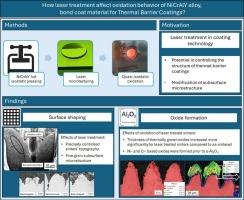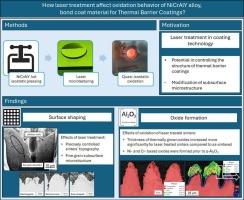Influence of laser shaping of the topography of NiCrAlY sinters on the surface oxidation mechanism under high-temperature conditions
IF 6.9
2区 材料科学
Q2 CHEMISTRY, PHYSICAL
引用次数: 0
Abstract
This work presents the idea of functionalization of bond coat surface in thermal barrier coatings technology. The laser surface shaping not only topographically alters the surface but also affects the interfacial behaviors in multilayer coating systems, significantly impacting e.g. high-temperature oxidation mechanisms.
In this study, NiCrAlY powder was sintered and then laser microtextured. The free-standing sinters with six various topographies were then exposed to isothermal oxidation at 1100 °C and the dwell-time in range of 1 to 168 h. The further microstructural studies were aimed at exploring the correlation between microtexturing parameters, the resulting topography, and high-temperature oxidation mechanisms. The topographical evolution of the laser-treated sinters was analyzed using a scanning electron microscopy and confocal microscopy. Additionally, high-resolution electron microscopy coupled with in-situ focused ion beam etching and energy-dispersive spectroscopy, as well as electron backscatter diffraction were utilized to examine the migration of chemical elements and the final composition of thermally grown oxides, while x-ray diffraction was used to investigate surface oxide formations. The observations revealed that laser surface processing results in fine subsurface microstructure related to rapid free-cooling. Microstructural changes further affected the high-temperature behavior of NiCrAlY powder by altering the oxidation kinetics and oxide formation during isothermal oxidation.


高温条件下激光形貌对NiCrAlY烧结矿表面氧化机理的影响
本文提出了热障涂层技术中粘结层表面功能化的思想。激光表面整形不仅改变了表面形貌,而且影响了多层涂层系统的界面行为,如高温氧化机制。在本研究中,NiCrAlY粉末被烧结,然后激光微织构。将具有6种不同形貌的独立烧结矿在1100 °C和1 ~ 168 h的温度下进行等温氧化。进一步的显微组织研究旨在探索微织构参数、形貌和高温氧化机制之间的关系。利用扫描电镜和共聚焦显微镜分析了激光处理烧结矿的形貌演变。此外,高分辨率电子显微镜结合原位聚焦离子束刻蚀和能量色散光谱,以及电子背散射衍射被用来检查化学元素的迁移和热生长氧化物的最终组成,而x射线衍射被用来研究表面氧化物的形成。观察结果表明,激光表面处理产生了与快速自由冷却有关的精细亚表面微观结构。显微组织的变化通过改变NiCrAlY粉末在等温氧化过程中的氧化动力学和氧化物形成进一步影响了NiCrAlY粉末的高温行为。
本文章由计算机程序翻译,如有差异,请以英文原文为准。
求助全文
约1分钟内获得全文
求助全文
来源期刊

Applied Surface Science
工程技术-材料科学:膜
CiteScore
12.50
自引率
7.50%
发文量
3393
审稿时长
67 days
期刊介绍:
Applied Surface Science covers topics contributing to a better understanding of surfaces, interfaces, nanostructures and their applications. The journal is concerned with scientific research on the atomic and molecular level of material properties determined with specific surface analytical techniques and/or computational methods, as well as the processing of such structures.
 求助内容:
求助内容: 应助结果提醒方式:
应助结果提醒方式:


